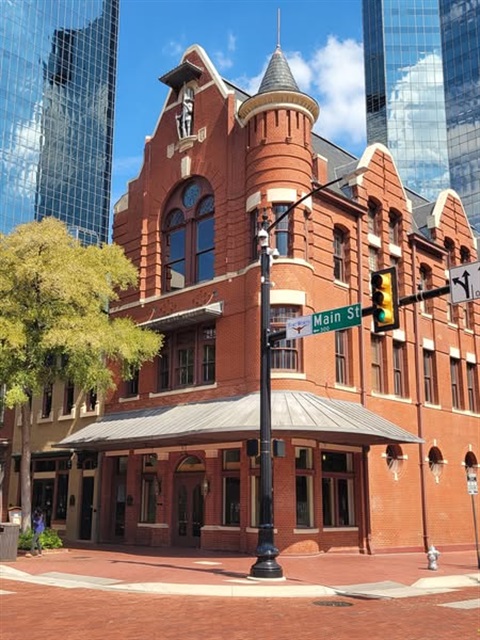Fort Worth’s Main Street has changed dramatically over the past century, but one striking building still stands sentry with its red brick façade, medieval turrets and watchful stone knight. The Knights of Pythias Hall, at 315 Main St., is more than just a pretty face — it’s a rare surviving monument to fraternal society life, early urban commerce and Fort Worth’s ambition at the turn of the 20th century.
America’s First Pythian Castle Hall
In 1881, the Knights of Pythias — a fraternal order founded during the Civil War to promote friendship, charity and benevolence — chose Fort Worth as the site of their first Castle Hall in the United States. The original wooden structure quickly became a center of civic life. But tragedy struck in 1901, when a fire destroyed the hall and much of the surrounding block.
The Pythians responded by commissioning prominent local architects Sanguinet & Staats to design a new hall worthy of the growing city. Completed later that year, the new red-brick building drew inspiration from Flemish guild halls and medieval castles — an architectural nod to the order’s imagery. The hall’s distinctive, small corner tower and the carved knight perched up high above Main Street made it an instant landmark.
The upper floors hosted lodge meetings and social events, while the ground floor welcomed a rotating cast of commercial tenants. Among the most notable were Renfro Drug No. 1, Fort Worth’s first offset printing press, and even one of the city’s earliest coin-operated laundromats. The continuous mix of fraternal and commercial activity reflected how the hall often doubled as both a community gathering place and an early downtown business hub.
Community downtown
The Knights of Pythias were not limited to only downtown. On Fort Worth’s East Side, African American Pythian members built their own Key West Lodge Hall at 900 E. Second St. in 1925. This two-story brick building featured storefronts at street level and a large upstairs auditorium — serving as a vital community center until the lodge closed in the late 1940s. The hall later housed local Black-owned businesses, including Atlanta Life Insurance and Artistic Beauty Shop. Decades later, it was restored and adapted into apartments, preserving its historic façade and community legacy.
Preservation and legacy
By the mid-20th century, fraternal orders began to diminish in influence, and many such halls were demolished or fell into poor condition. Fort Worth’s downtown Pythian Hall survived, largely thanks to its prominent location and commercial tenants. In 1970, it was listed on the National Register of Historic Places, and during the 1980s Sundance Square revitalization, the building was carefully restored.
Notably, it also housed the iconic Haltom’s Jewelers up until last January, when the longtime owners officially retired from the retail business. The jewelers featured an old-timey clock tower, beloved by Fort Worth residents for decades. It stood as one of the most recognizable symbols of Fort Worth’s architectural and social history until it was relocated earlier this year.
From secret meetings and grand balls to printing presses and pharmacies, the Knights of Pythias Hall has worn many hats — all beneath the one unmistakable tower. Its survival is a reminder of how fraternal organizations helped shape Fort Worth’s early downtown scene, leaving behind some of the city’s most enduring landmarks.






